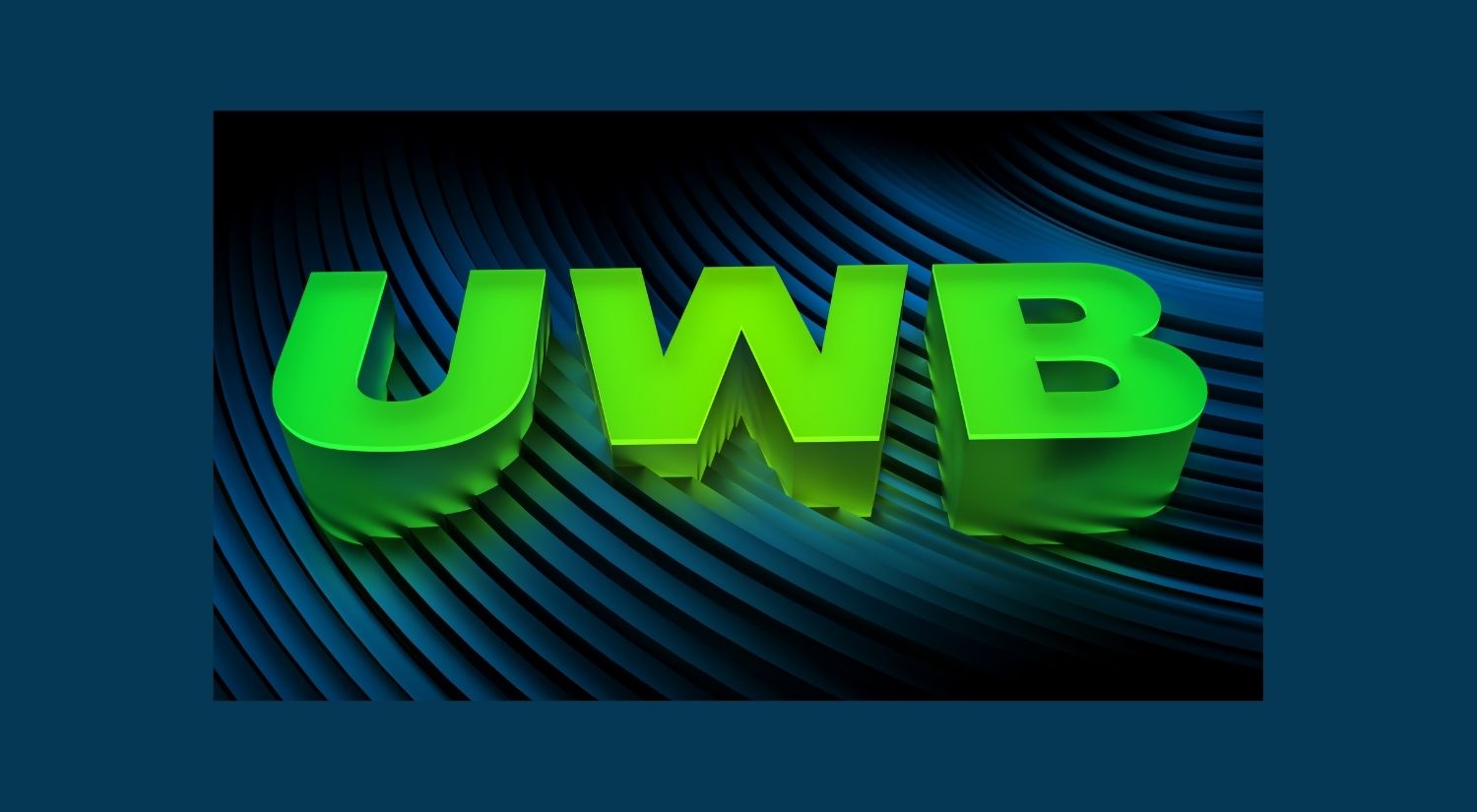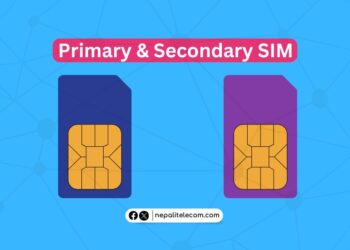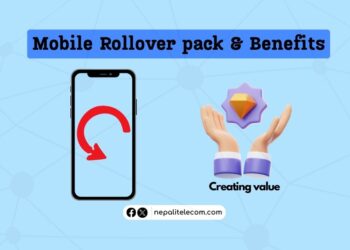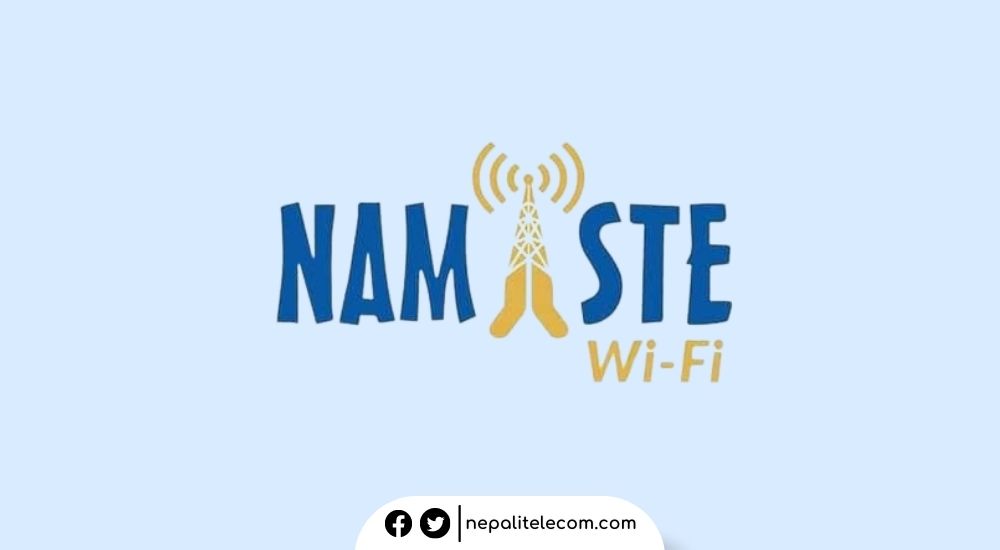There are many technologies coming up with the passage of time. You might have heard the term UWB, Ultra-Wide Band technology somewhere. We recently saw the incorporation of the tech in the new Samsung Galaxy Note 20 Ultra, but they were already available on Apple iPhone 11. It is not a new technology though, UWB is a 132-year-old wireless communication technology that has made a comeback in today’s era. So, here in this article we will give you all the details about what UWB is, how does it work, and its advantages, and disadvantages, and many more.
Table of contents
UWB ( Ultra-Wide Band)
Introduction
First of all, UWB stands for Ultra-Wide Band. Ultra Wide Band (UWB) technology is a short-range wireless technology similar to that of WiFi or Bluetooth but it is more precise, reliable, and fast. It is a wireless technology for the transmission of a high amount of digital data and information using radio waves over a spectrum of frequencies. Find all of the spectrum bands for mobile networks in Nepal.
Ultra-Wide Band operates over a wide frequency spectrum that ranges from 3.1 to 10.6 GHz. It can determine the relative position of other devices in the line of sight up to 200 meters.
History Of Ultra-Wide Band
Talking about the history of Ultra-Wide Band technology, it has a very long history of 132 years. We will have to dive back in the past to know about the technology, it was at the end of the 19th century when G. Marconi used spark-gap transmitters in transatlantic radio communication. In 1920, UWB signals were banned for commercial use and restricted to military applications. The technology only began to attract attention and peak the interest of the scientific community at the end of the 20th century.
In 2002, the United States Federal Communications Commission (FCC) published the UWB regulations for the first time. The regulations allowed unlicensed use of the assigned spectrum for UWB, just like the usage of WiFi, Bluetooth. They have also allowed the power limit to a very low value so as to avoid interference with other technologies such as WiFi, Bluetooth, etc.
Though technology came to the light for scientists and researchers in this decade, it came to commercial use only recently.
How Does Ultra-Wide Band Work?
Talking about the working principle of the Ultra-Wide Band technology, it is a wireless communication protocol that utilizes radio waves like Bluetooth and WiFi. It works by sending billions of radio pulses across the wide spectrum and after receiving the pulses, the receiver translates the pulses into data. Ultra Wide Band (UWB) is able to achieve real-time accuracy as it sends billions of Pulses one every two nanoseconds.
The operating technology of UWB follows the Shanon-Hartley Channel Capacity theorem. That means UWB technology increases the channel capacity with a significant bump in the operating Bandwidth.
A MIMO (multiple-input and multiple-output), distributed antenna system has been added to further increase the range and reception reliability of the Ultra Wide Band (UWB) technology. It also enables the short-range networks and the antennas can be embedded into a smartphone or other various IoT devices.
When a UWB-enabled device such as a smartphone, smartwatch, smart key, which comes near to other UWB devices, they start “ranging” or measuring the distance between the device. It refers to calculating the Time of Flight (ToF) between the two devices.
The wireless technology goes on to utilize very low power whereas the bandwidth is very high (500MHz), which enables delivering huge data from a transmitter to other devices. The range of the UWB communication is around a couple of tens of feet, and the UWB signal cannot even penetrate the walls.
How to use UWB in Samsung Note 20 Ultra?
To use UWB in Samsung Note 20 Ultra,
- You need to point your phone towards the direction where other UWB enabled phones are.
- You will get the devices listed in the “Nearby Share” option on your phone. Point to Share feature works quite promptly so that you do not need to scan devices for such communication.
- Then you can share files, documents, links, videos quickly to nearby UWB enabled devices. You can also connect to SmartThings/IoT devices with your phone instantly.
Advantages
The short-range wireless technology UWB arrives with many advantages. Some of the benefits of Ultra Wide Band are listed below:
- Ultra-Wide Band consumes very low power that is one of the most important factors. So you will be working for a long interval of time with a UWB device even if you have got low battery power.
- The wide bandwidth provides immunity against the channel effect in a dense environment and enables very fine time-space resolutions for highly accurate indoor positioning of the UWB nodes, e.g., the new iPhone 11.
- In the case of UWB, there is a very low chance of signal interference. Ultra-Wide Band uses 3.1–10.6GHz frequency and the low spectral density ensures a low probability of signal detection.
- Ultra Wide Band technology is ultra-fast. You can transmit high data rates over a short distance very fast with the use of UWB technology. It takes no time to pinpoint the location of the next devices.
- Ultra-Wide Band systems are capable of co-existing with the already-deployed narrowband systems.
Disadvantages
It also has some short-comings along with its many benefits. The most noticeable drawback of the Ultra Wide Band technology is the short coverage issue of the wireless communication technology. It uses a large frequency spectrum and interferes with other wireless standards sharing the same frequencies. So, therefore it is vulnerable to other wireless communication systems and prone to human interference.
Uses Of UWB
There are various applications of the Ultra Wide Band Technology. Some of the uses of UWB technology are listed below:
- Same as that of the NFC you will be able to do wireless payments using Ultra Wide Band Technology and it is even more secure than it.
- You will be able to unlock and access your vehicle or car with your smartphone as soon as you approach for keyless entry and remote start.
- It is also used in the field of sports to track the performance and fitness of the players in the field. The NFL is already tracking their players on the ground for instant replay animations with UWB transmitters in each shoulder pad.
- It is used for a secure Building Access to people. When you approach the building the doors will automatically open for you.
- Ultra Wide Band Technology is also used for tracking your assets that will make it faster and easier to find them.
- They are used for smart retailing. It will provide you with useful information about your desired product and also lets you know about a special offer for buying one.
- Ultra-Wide Band is also used in the health and medical sectors. They are used for monitoring and tracking the heartbeat and respiration of the patient.
UWB in Nepal
With the formulation of Radio Frequency policy 2079, NTA has allowed to use UWB in Nepal with free of charge. But there is a requirement for not to interfere with other telecom services and should be used on non-exclusive and non-protective basis.
NTA limits the radiated power in UWB by Maximum Mean EIRP Spectral Density: -41.3 dBm/MHz र Peak EIRP: 0 dBm in 50 MHz. So, you can use UWB for short range applications for free, without any charges for spectrum band.
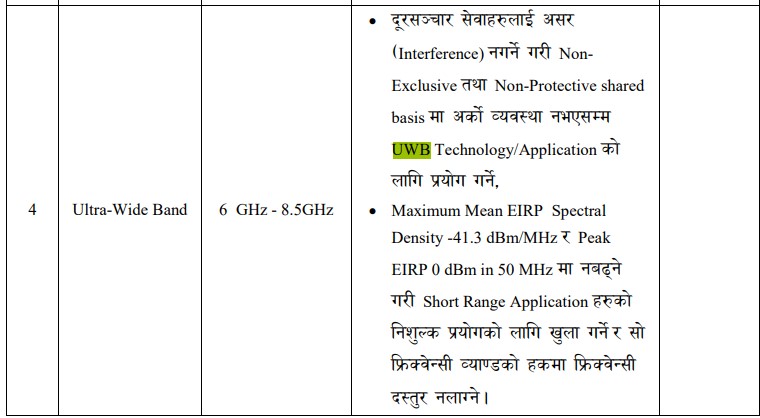
Differences between UWB, NFC, WiFi, and Bluetooth.
Comparing all these wireless communication technologies it feels like Ultra Wide Band technology has a little edge over them. We have made a brief comparison between the wireless communication technology in the table below:
| Specifications | WiFi | Bluetooth | NFC | UWB |
| Range | 100meter | 100meter | 10Cm | 200 meters |
| Frequency Band (Spectrum) | 2.4GHz, 5GHz | 2.4GHz | 13.56MHz | 3.1 – 10.6GHz |
| Accuracy | few meters | Up to a meter | few centimeters | 10 centimeters |
| Battery | Works on AC (No Battery) | Low Consumption | No Battery | Low Consumption |
| Data Rate | 144 Mbps | 22 Mbps | 106, 212, 424Kbps | 480 Mbps |
| Cost | High | Low | moderate | Low |
Also read: How to get an internet connection at home in Nepal?
Smartphones supporting UWB (Ultra-Wide Band Technology)
Right now, UWB has started supporting from Apple’s iPhone 11, iPhone 11 Pro, and iPhone 11 Pro Max and Samsung Galaxy Note 20 and Samsung Z Fold 2. As of now, there are not many smartphones with this feature, but many other tech giants are researching and integrate it soon. We hope that many other phone brands like Xiaomi, Oppo, and OnePlus will be following Apple’s path.
The UWB is available in selected flagship phones only for now, but we can also expect this technology in premium mid-range phones like those priced under Rs 50,000.
Conclusion
Ultra-Wide Band technology is one of the fast, secure, and low power consuming wireless communication technology. It is yet to be introduced to many other aspects of the digital ecosystem globally and so is for Nepal. Though the NTA has approved to its usage. But UWB technology has vast potential, and we can look forward to this technology in the future.
In comparison with other wireless communication technology, it comes ahead and has an edge on the competitors. The technology could provide the answer to the global pandemic for various problems that we are facing right now. As we will be able to do our tasks and daily routines without physical contact, it helps to prevent the spread of viruses. So, what is your thought about this 132-year communication technology: UWB?


